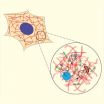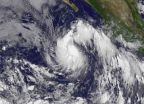(Press-News.org) (Boston)-- Researchers from Boston University School of Medicine (BUSM) report that a tumor suppressor pathway, called the Hippo pathway, is responsible for sensing abnormal chromosome numbers in cells and triggering cell cycle arrest, thus preventing progression into cancer.
Although the link between abnormal cells and tumor suppressor pathways—like that mediated by the well known p53 gene—has been firmly established, the critical steps in between are not well understood. According to the authors, whose work appears in Cell, this work completes at least one of the missing links.
Normal human cells contain 23 pairs of chromosomes, but this number doubles to 46 pairs as a cell prepares to divide. At the end of a normal cell division cycle, these chromosomes evenly divide to produce two identical cells with 23 pairs of chromosomes each. Sometimes, however, errors occur during division and cells fail to divide properly, resulting in giant cells with double the number of chromosomes, known as a tetraploid cells. Normally, p53 dependent pathways stop these tetraploid cells from proliferating. This response is critical because those tetraploid cells that escape detection can facilitate cancer development: Recent studies suggest that as many as 40% of all solid tumors have passed through a tetraploid stage at some point during their development. Thus, there has been great interest in understanding how a cell "knows" it has a tetraploid complement of chromosomes and is in need of tumor suppression.
Using a technique known as genome-wide screening, the scientists systematically depleted every human gene from tetraploid cells in order to discover which ones were important to prevent proliferation. They found that when one specific gene, LATS2, was eliminated, the arrested tetraploid cells resumed proliferation, thus demonstrating that LATS2 was an upstream gene responsible for halting abnormal cell division. The LATS2 gene is known to activate the Hippo tumor suppressor pathway, which is the same pathway our bodies use to ensure our vital organs don't grow out of control. Now, the authors demonstrate that the Hippo pathway also represents the underlying pathway that prevents tetraploid cells from proliferating and causing tumors. "Although more studies are needed to further clarify this critical pathway, this work may help guide the development of new therapies that specifically target tumor cells with abnormal numbers of chromosomes, while sparing the normal healthy cells from which they originated," explained corresponding author Neil J. Ganem, PhD, Assistant Professor of Pharmacology and Medicine in the Shamim and Ashraf Dahod Breast Cancer Research Laboratories at BUSM.
INFORMATION:
Funding for this study was provided in part by a K99/R00 from the National Cancer Institute.
Researchers identify a mechanism that stops progression of abnormal cells into cancer
2014-08-14
ELSE PRESS RELEASES FROM THIS DATE:
Researchers develop strategy to combat genetic ALS, FTD
2014-08-14
JACKSONVILLE, Fla. — A team of researchers at Mayo Clinic and The Scripps Research Institute in Florida have developed a new therapeutic strategy to combat the most common genetic risk factor for the neurodegenerative disorders amyotrophic lateral sclerosis (ALS or Lou Gehrig's disease) and frontotemporal dementia (FTD). In the Aug. 14 issue of Neuron, they also report discovery of a potential biomarker to track disease progression and the efficacy of therapies.
The scientists developed a small-molecule drug compound to prevent abnormal cellular processes caused by a ...
Inside the cell, an ocean of buffeting waves
2014-08-14
Cambridge, Mass. – August 14, 2014 – Conventional wisdom holds that the cytoplasm of mammalian cells is a viscous fluid, with organelles and proteins suspended within it, jiggling against one another and drifting at random. However, a new biophysical study led by researchers at Harvard University challenges this model and reveals that those drifting objects are subject to a very different type of environment.
The cytoplasm is actually an elastic gel, it turns out, so it puts up some resistance to simple diffusion. But energetic processes elsewhere in the cell—in the cytoskeleton, ...
Forcing chromosomes into loops may switch off sickle cell disease
2014-08-14
Scientists have altered key biological events in red blood cells, causing the cells to produce a form of hemoglobin normally absent after the newborn period. Because this hemoglobin is not affected by the inherited gene mutation that causes sickle cell disease, the cell culture findings may give rise to a new therapy for the debilitating blood disorder.
The novel approach uses protein-engineering techniques to force chromatin fiber, the substance of chromosomes, into looped structures that contact DNA at specific sites to preferentially activate genes that regulate hemoglobin. ...
NASA sees Tropical Storm Julio now far from Hawaii
2014-08-14
Hurricane Julio moved past the Hawaiian Islands like a car on a highway in the distance, and NASA's Terra satellite captured an image of the storm, now downgraded to a tropical storm located more than 700 miles away. Julio is far enough away from Hawaii so that there are no coastal watches or warnings in effect.
On August 13 at 21:10 UTC (5:10 p.m. EDT), the Moderate Resolution Imaging Spectroradiometer of MODIS instrument aboard NASA's Terra satellite captured a visible image of Hurricane Julio moving through the Central Pacific Ocean. The visible image shows that powerful ...
EARTH Magazine: Are slow-slip earthquakes under Tokyo stressing faults?
2014-08-14
Alexandria, Va. — Tokyo, a city of more than 13 million people, has been devastated by earthquakes in the past and likely will be again. But when? And what role do ongoing slow-slip earthquakes — the kind that generally can't be felt at the surface — play in relieving or building up stress?
New research examining plate movements under Tokyo has found that since the massive magnitude-9 Tohoku earthquake and tsunami in March 2011, recurrence intervals for nondamaging slow-slip quakes beneath Japan's capital have shortened. That has left seismologists wondering if this aseismic ...
A husband's declining health could put Taiwanese women at risk for health issues
2014-08-14
PRINCETON, N.J.—The death of a spouse undoubtedly brings with it stress, anxiety and uncertainty. Now, a report by Princeton University's Woodrow Wilson School of Public and International Affairs quantifies this stress, showing how a husband's declining health could put Taiwanese women at risk for health issues.
Using data from a longitudinal sample of Taiwanese older adults, the researchers found that the more a husband suffered, the more his wife's glucose levels increased. Yet, when a wife's health was declining, her husband's levels remained the same. Being widowed, ...
High prevalence of opioid use by Social Security disability recipients, reports Medical Care
2014-08-14
August 14, 2014 – More than 40 percent of Social Security Disability Insurance (SSDI) recipients take opioid pain relievers, while the prevalence of chronic opioid use is over 20 percent and rising, reports a study in the September issue of Medical Care. The journal is published by Lippincott Williams & Wilkins, a part of Wolters Kluwer Health.
The high proportion of SSDI recipients who are chronic opioid users—in many, at high and very high daily doses—"is worrisome in light of established and growing evidence that intense opioid use to treat non-malignant [non-cancer] ...
Tropical Storm Karina forms in Eastern Pacific near Socorro Island
2014-08-14
Socorro Island in the Eastern Pacific received an unwelcome tropical visitor on the morning of August 13 when satellite data confirmed the formation of Tropical Storm Karina.
Karina strengthened from the eleventh tropical depression in the Eastern Pacific. Tropical Depression 11-E formed at 11 p.m. EDT on August 12. Just twelve hours later at 11 a.m. EDT, the depression had become better organized and winds increased to tropical storm strength.
NOAA's GOES-West satellite captured an infrared image of newborn Tropical Storm Karina approaching Socorro Island in the Eastern ...
NASA sees fragmented thunderstorm bands wrapped around Tropical Storm Karina
2014-08-14
Although Tropical Storm Karina is still strengthening in the Eastern Pacific Ocean NASA's Aqua satellite revealed a large band of fragmented thunderstorms wrapping into its center from the north.
On August 13 at 21:00 UTC (5 p.m. EDT), the MODIS or Moderate Resolution Imaging Spectroradiometer instrument aboard NASA's Aqua satellite captured a visible image of Tropical Storm Karina off the west coast of Mexico. The image showed a concentration of strong thunderstorms around the center of circulation while the band of thunderstorms to the north appeared broken. The strongest ...
Novel treatment strengthens bones in genetic disease neurofibromatosis type-1
2014-08-14
An enzyme therapy may prevent skeletal abnormalities associated with the genetic disorder neurofibromatosis type-1, Vanderbilt investigators have discovered.
The researchers demonstrated in a mouse model of the disorder that the enzyme asfotase-alpha improves bone growth, mineralization and strength. The findings, reported in the August issue of Nature Medicine, "suggest that we can make bone stronger and better by injecting this drug, and possibly prevent fractures in patients with neurofibromatosis," said Florent Elefteriou, Ph.D., director of the Vanderbilt Center for ...




